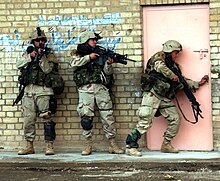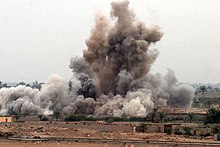Second Battle of Fallujah
After that battle, control of the city was transferred to an Iraqi-run local security force, which began stockpiling weapons and building complex defenses.Shortly afterward, on 31 March 2004, four American private military contractors from Blackwater – Wesley Batalona, Scott Helvenston, Jerry Zovko, and Michael Teague – were ambushed and killed in the city.[26] Although tactical commanders in Iraq considered these deaths militarily insignificant, U.S. political leaders disapproved of a measured approach targeting the perpetrators and instead requested a larger assault into the city.[27] A leak later revealed that the main factor behind this[clarification needed] wasn't the killings themselves, but the circulation of images of the event which served as a symbol of opposition to American forces in Iraq.[29] Insurgent strength and control began to grow to such an extent that by 24 September 2004, a senior U.S. official told ABC News that catching Abu Musab al-Zarqawi, said to be in Fallujah, was now "the highest priority," and estimated his troops at 5,000 men, mostly non-Iraqis.They blocked streets with Jersey barriers and even emplaced them within homes to create strong points behind which they could attack unsuspecting troops entering the building.[41] Intelligence briefings given prior to battle reported that coalition forces would encounter Chechen, Filipino, Saudi, Libyan, and Syrian combatants, as well as native Iraqis.[46] With Navy SEAL and Marine Recon Snipers providing reconnaissance and target marking on the city perimeter, ground operations began on the night of 7 November 2004.2nd Infantry Division, Manchu, Charlie Co 1-9 Infantry Mechanized with 1st and 2nd platoons, (US Army) SEAL Sniper Task Elements from Naval Special Warfare Task Group Central and the U.S. Marine Corps Scout Platoons, captured Fallujah General Hospital, Blackwater Bridge, ING building, and villages opposite of the Euphrates River along Fallujah's western edge.The RCTs were augmented by three 7-man SEAL Sniper Teams from Naval Special Warfare Task Group-Central and one platoon from 1st Recon, who provided advance reconnaissance in the city, Joint Terminal Aircraft Control (JTAC) and unilateral overwatch throughout the operation.The six battalions of U.S. and Iraqi forces, aided by Marine Corps Scout and Target Acquisition, SEAL Sniper, and JTAC elements pre-fire operations, moved into the city under the cover of darkness; and once aligned with the reconnaissance elements, began the assault in the early hours of 8 November 2004, preceded by an intense artillery barrage firing some 2500 155mm projectiles and air attack.While most of the fighting subsided by 13 November 2004, U.S. Marines and Special Operations Forces continued to face determined isolated resistance from insurgents hidden throughout the city.By late January 2005, news reports indicated U.S. combat units were leaving the area, and were assisting the local population in returning to the now heavily damaged city.[64] The 3rd Marine Air Wing (aviation assets only) expended 318 precision bombs, 391 rockets and missiles, and 93,000 machine gun and cannon rounds.Tactics developed in what has been called the "Third Battle of Fallujah," when applied on a larger scale in Ramadi and the surrounding area, led to what became known as "the Great Sunni Awakening."Al Qaeda-linked Sunni insurgents from the Islamic State in Iraq and the Levant subsequently took over Fallujah and parts of Ramadi in early 2014 and the city was reclaimed by the Iraqi Army and Special Operations Units in June 2016.Included were graphic video and photos of severe and deep chemical burns that penetrated the flesh and bones of men, women, and children.However, later the same day, US Department of Defense spokesman Lieutenant Colonel Barry Venable confirmed to the BBC that US forces had used white phosphorus as an incendiary weapon there."[86][87] On November 16, 2005, BBC News reported that an article published in the March–April 2005 issue of Field Artillery, a U.S. Army magazine, noted that white phosphorus had been used during the battle.We used it for screening missions at two breeches and, later in the fight, as a potent psychological weapon against the insurgents in trench lines and spider holes where we could not get effects on them with HE [High Explosives].They leveled thousands of buildings, illegally denied access to the Iraqi Red Crescent and, according to the UN's special rapporteur, used "hunger and deprivation of water as a weapon of war against the civilian population".[94] A July 2009 paper by Buzby et al. reported a high level of cancer, birth defects and infant mortality, according to a house-to-house survey in Fallujah."[97] The results of a 2010 study at Fallujah General Hospital, published in 2012, concluded that, "the higher rates of congenital anomalies are believed to be caused by exposure to some genotoxic agent, possibly uranium.












Battle of Fallujah (disambiguation)Phantom Fury (video game)Iraq Warwar on terrorU.S. Marines4th Battalion, 14th MarinesM198 howitzerCamp FallujahFallujahAnbar GovernorateUnited StatesUnited KingdomAl-Qaeda in IraqIslamic Army in IraqAnsar al-Sunnah1920 Revolution BrigadesKeith J. StalderRichard F. NatonskiJames CowanAbu Musab al-ZarqawiAbdullah al-JanabiAbu Ayyub al-MasriIraq Body CountRed CrossOutlineTimelineInvasion (2003)Umm QasrAl Faw1st BasraNasiriyahRaid on KarbalaHaditha Dam1st NajafNorthern DelayViking HammerSamawah1st KarbalaAl KutHillahKarbala GapDebecka PassBaghdadPost-invasion insurgency (2003–2006)Al AnbarKilling of Qusay & Uday Hussein1st RamadanLatifiyaCapture of Saddam HusseinSpring 2004City HallIron Saber1st FallujahSadr City1st RamadiGood FridayHusaybahDanny Boy2nd NajafCIMIC-HouseSamarraLake ThartharAl Qa'imHadithaSteel CurtainTal Afar2nd RamadiTogether ForwardDiwaniyaCivil war (2006–2008)2nd RamadanSinbadAmarahDiyalaHaifa StreetKarbala Raid3rd NajafImposing LawU.K. basesBlack EagleBaghdad beltsAlljahBaqubahDonkey IslandShurta NasirPhantom Strike2nd KarbalaPhantom PhoenixInsurgency (2008–2011)2008 Day of AshuraNinevehSpring 20082nd Basra2008 al-Qaeda OffensiveAugurs of ProsperityAbu KamalPalm GroveCamp AshrafUS withdrawal violenceList of bombings during the Iraq War1st Baghdad2nd Baghdad3rd Baghdad1st Nasiriyah‡ 1st Erbil‡ Ashoura1st Mosul4th Baghdad5th BaghdadKarbala & Najaf1st BaqubahSuwaira bombing‡ 1st Al Hillah2nd Erbil‡ Musayyib6th Baghdad‡ 7th Baghdad1st BaladKhanaqin‡ Karbala-Ramadi1st Samarra8th Baghdad9th Baghdad‡ 10th Baghdad11th Baghdad12th Baghdad